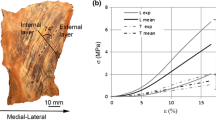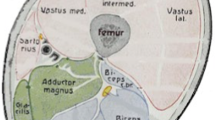Abstract
The present work focuses on the numerical modeling of the mechanical behavior of the crural fascia, the deep fascia enwrapping the lower limb muscles. This fascia has an important biomechanical role, due to its interaction with muscles during contraction and its association with pathological events, such as compartment syndrome. The mechanical response of the crural fascia is described by assuming a hyperelastic fiber-reinforced constitutive model, with families of fibers disposed according to the spatial disposition of the collagen network, as shown in histological analyses. A two-dimensional finite element model of a lower limb transversal section has been developed to analyze deformational behavior, with particular attention on interaction phenomena between crural fascia and enwrapped muscles. The constitutive model adopted for the crural fascia well fits experimental data taken along the proximal–distal and medial–lateral directions. The finite element analysis allows for interpreting the relation between change in volume and pressure of muscle compartments and the crural fascia deformation.






Similar content being viewed by others
References
Annaidh AN, Bruyère K, Destrade M, Gilchrist MD, Otténio M (2013) Characterising the anisotropic mechanical properties of excised human skin. J Mech Behav Biomed Mater 5(1):139–148
Azizi E, Halenda GM, Roberts TJ (2009) Mechanical properties of the gastrocnemius aponeurosis in wild turkeys. Integr Comp Biol 49(1):51–58
Benettazzo L, Bizzego A, De Caro R, Frigo G, Guidolin D, Stecco C (2010) 3D reconstruction of the crural and thoracolumbar fasciae. Surg Radiol Anat 33:855–862
Benjamin M (2009) The fascia of the limbs and back: a review. J Anat 214:1–18
Corana A, Marchesi M, Martini C, Ridella S (1987) Minimizing multimodal functions of continuous variables with the simulated annealing algorithm. ACM Trans Math Softw 13(3):262–280
Dahl M, Hansen P, Stål P, Edmundsson D, Magnusson SP (2011) Stiffness and thickness of fascia do not explain chronic exertional compartment syndrome. Clin Orthop Relat Res 469:3495–3500
French EZ, Price WH (1962) Anterior tibial pain. Br Med J 2:1290
Geerligs M, Peters WMG, Ackermans PAJ, Oomens CWJ, Baaijens FTP (2008) Linear viscoelastic behavior of subcutaneous adipose tissue. Biorheology 45:677–688
Gershuni DH, Gosink BB, Hargens AR, Gould RN, Forsythe JR, Mubarak SJ, Akeson WH (2011) Ultrasound evaluation of the anterior musculofascial compartment of the leg following exercise. Clin Orthop Relat Res 10:59–65
Hargens AR, Schmidt DA, Evans KL, Gonsalves MR, Cologne JB, Garfin SR, Mubarak SJ (1981) Quantitation of skeletal-muscle necrosis in a model compartment syndrome. J Bon Joint Surg Am 63(4):631–636
Holzapfel GA, Gasser TC, Ogden RW (2000) A new constitutive framework for arterial wall mechanics and a comparative study of material models. J Elast 61:1–48
Hurschler C, Vanderby R, Martinez DA, Vailas AC, Turnipseed WD (1994) Mechanical and biomechanical analyses of tibial compartment fascia in chronic compartment syndrome. Ann Biomed Eng 22:272–279
Mattei CP, Beca S, Zahouani H (2008) In vivo measurements of the elastic mechanical properties of human skin by indentation tests. Med Eng Phys 30:599–606
Mubarak SJ, Owen CA, Hargens AR, Garetto LP, Akeson WH (1978) Acute compartment syndromes: diagnosis and treatment with the aid of the wick catheter. J Bon Joint Surg Am 60(8):1901–1905
Natali AN, Carniel EL, Pavan PG (2008) Constitutive modelling of inelastic behaviour of cortical bone. Med Eng Phys 30(7):905–912
Natali AN, Pavan PG, Stecco C (2010) A constitutive model for the mechanical characterization of the plantar fascia. Connect Tissue Res 51(5):337–346
Pavan P, Stecco C, Pachera P, Natali AN (2012) Assessment of the mechanical properties of the human crural fascia. In: Cappozzo A, D’Alessio T, Guglielmelli E, Pennestrì E, Salinari S (eds) Congresso Nazionale di Bioingegneria. Patròn, Bologna, pp 191–192
Pfaeffle HJ, Toamino MM, Grewal R, Xu J, Boardman ND, Woo SL, Herndon JH (1996) Tensile properties of the interosseous membrane of the human forearm. J Orthop Res 14(5):842–845
Simmonds N, Miller P, Gemmel H (2010) A theoretical framework for the role of fascia in manual therapy. J Bodywork Mov Ther 16:83–93
Spencer AJM (1971) Theory of invariants. In: Eringen AC (ed) Continuum physics, vol 1. Academic Press, New York, pp 239–353
Stecco C, Porzionato A, Lancerotto L, Stecco A, Macchi V, Day JA, De Caro R (2008) Histological study of the deep fascia of the limbs. J Bodywork Mov Ther 12(3):225–230
Stecco A, Macchi V, Masiero S, Porzionato A, Tiengo C, Stecco C, Delmas V, De Caro R (2008) Pectoral and femoral fasciae: common aspects and regional specializations. Surg Radiol Anat 31(1):35–42
Stecco C, Pavan PG, Porzionato A, Macchi V, Lancerotto L, Carniel EL, Natali AN, De Caro R (2009) Mechanics of crural fascia: from anatomy to constitutive modelling. Surg Radiol Anat 31:523–529
Stecco S, Porzionato A, Lancerotto L, Stecco A, Macchi V, Day JA, De Caro R (2009) Anatomical study of myofascial continuity in the anterior region of the upper limb. J Bodywork Mov Ther 13:53–62
Stecco C, Porzionato A, Lancerotto L, Stecco A, Masiero S, Day JA, De Caro R (2009) The pectoral fascia: anatomical and histological study. J Bodywork Mov Ther 13:255–261
Stecco C, Pavan PG, Pachera P, De Caro R, Natali AN (2013) Investigation of the mechanical properties of the human crural fascia and their possible clinical implications. Surg Radiol Anat pp 1–8, doi: 10.1007/s00276-013-1152-y (in press)
van Donkelaar CC, Huyghe JM, Vankan WJ, Drost MR (2001) Spatial interaction between tissue pressure and skeletal muscle perfusion during contraction. J Biomech 34:631–637
Warme WJ, Matesen FA (2013) Compartmental Syndromes. http://www.orthop.washington.edu/?q=patient-care/articles/shoulder/compartmental-syndromes.html. Accessed 26 Nov 2013
Author information
Authors and Affiliations
Corresponding author
Rights and permissions
About this article
Cite this article
Pavan, P.G., Pachera, P., Stecco, C. et al. Biomechanical behavior of human crural fascia in anterior and posterior regions of the lower limb. Med Biol Eng Comput 53, 951–959 (2015). https://doi.org/10.1007/s11517-015-1308-5
Received:
Accepted:
Published:
Issue Date:
DOI: https://doi.org/10.1007/s11517-015-1308-5




